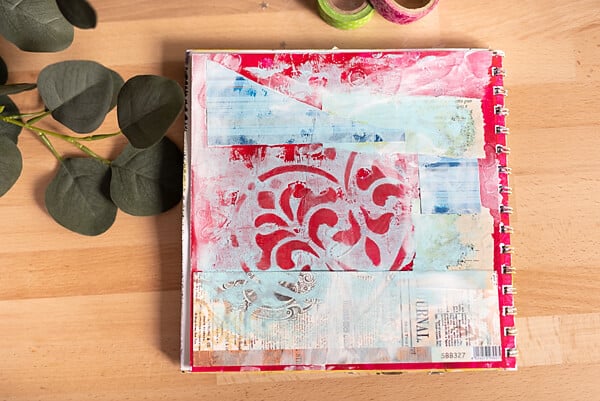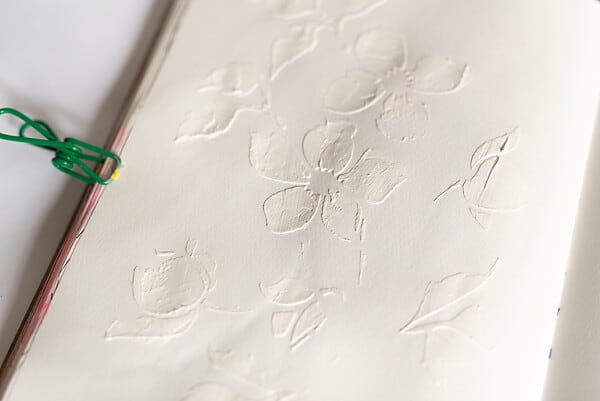What Is Gesso And How To Use It In Art Journaling – A Beginner’s Guide
You’ve heard other artists talk about gesso for art journaling but you still aren’t quite sure why and how to use it and whether you even care about having it.
What I’ve been asked a lot is what gesso is, what to use it for, if it’s really necessary, and many other questions. So, my purpose today is to give you an introduction to this art supply and to answer 17 practical questions about gesso for art journaling.
Disclaimer: Some links in this post may be affiliate links. This means that if you purchase something through that link, I get a small commission, at no extra cost to you.
1. What is gesso?
Gesso was primarily used for priming canvases before painting with acrylic paint. The word gesso means chalk in Italian. Chalk is one of the ingredients of gesso.
It is mostly and widely used in art journaling for preparing the pages before you put a lot of different media on them.
Gesso tends to “lock” the paper’s ability to absorb, and thus the paint will remain on the surface, rather than bleed through the paper.

When the gesso is dry, the pages become sturdier and the paper won’t soak liquids.
Gesso is a great thing to use in mixed media projects and art journaling because if you do mixed media, you’ll definitely use a lot of paint and other liquid media. I talk more about gesso and mixed media later in the post.
2. Different types of gesso
There are different brands and kinds of Gesso. It also comes in white, black and transparent. I haven’t tried the transparent one, but I have it in mind.
White gesso
I love white gesso because I can achieve many different effects with it.
For example, I can use it as white acrylic paint.
Also, the best thing about white gesso is that you can make awesome mixed media pages. It somehow gives the pages a worn-out, vintage look, or you can make grungy pages by applying it almost dry with a brush, like in the photo below.

Black gesso
I just want to throw an idea here. If you want both, the white and the black gesso, but it seems too much to buy now, you can make your own!
Yes, try mixing black acrylic paint with gesso and see how that works. Easily made black gesso, right?
Transparent or clear gesso
If you just want to prime a page without changing its color or background, clear gesso is for you. It might seem white while it’s still wet, but once it’s dry, it goes fully transparent.
The quality of gesso
You’ll find the more expensive artist-grade gesso and the student-grade gesso.
I mostly buy the cheaper ones and use them often without worrying that I’m wasting expensive art supplies.
How do you know the difference? Well, it’s usually written on the packaging, or look at the prices, and it’ll be pretty obvious. The more expensive the gesso, the more quality you’ll get (this is a general rule for all supplies, but it isn’t always so. However, the store staff should know the difference).
But let me tell you one more time, just to give you a tip: if you’re going to use gesso for art journaling only, you can go with the cheaper options.
3. What is gesso used for?
Gesso is versatile. Apart from using it to prime the pages, it can serve many other purposes.
- to make pages sturdier
So you don’t have to glue two pages together (in case they’re thin).
- create texture
You can do this before you even start painting. The tools you use for this determine what kind and amount of texture you’ll get. The tools that give the most texture are a kitchen sponge and the brayer.
Read more about tools for applying gesso to paper here.
- to cover stuff
Are there pages that you don’t really like and would like to use the page again for something else you’ll perhaps love more? Of course, you have these pages, we all do.
Or have you experienced an Oops moment, like spilling too much ink on the page?
In any case, you can use gesso to cover stuff. Maybe you won’t be able to completely hide the previous page, but you’ll definitely get a faded background which can be interesting.
- tone down the color of your pages
When I feel my colors are too bold or bright, I just use a thin layer of gesso and tone the whole thing down. The effect of this technique is amazing. The hazy look you get is one of my favorites.
4. Where to buy gesso?
At any shop with art supplies, hobby shops, arts and crafts stores, etc. You can ask at the store which kind is the most popular with buyers and buy that one.
You can also buy many brands online on Amazon, Dick Blick, and similar stores.
5. How to thin gesso?
If you mix gesso with a bit of water, you thin it down and you can get a hazy look on your page. The layer of gesso will be very thin so you can use this technique to desaturate a colorful page.
In most cases, all you need to do is apply gesso with a big, wet gesso brush.
6. Can I mix gesso with acrylic paint?
Of course, you can. If you want to prime your page in any color, just add some paint to the gesso.
Experiment with the shades and the amount of paint, and tint it any way you like.
7. What is gesso drying time?
This certainly depends on the brand and the amount of gesso you apply on the page. If you put a thicker layer of gesso, it’ll need more time to dry, longer than acrylic paint in the same case.
However, if you apply just a light, thin layer, it’ll dry quickly. I usually use my heat gun to dry it faster, and with this tool, it’s a matter of seconds. Without the heat gun, you’ll usually have to wait for a few minutes (again, it all depends on the thickness of the layer).
8. Can I use gesso with watercolor?
I’ve tried this many times and I’m not satisfied. Some of my art journals have very thin pages.
I’ve always wanted to use watercolor in my journals, but for this, I needed a lot of water. So, I figured I’d just use gesso for priming and that’s it.
However, I didn’t like the results. First of all, the colors became desaturated and flowed easily over the page because the gesso made the surface smooth (I have a gesso that leaves a smooth, shiny surface).
It just doesn’t behave like watercolor paper. This isn’t good or bad, it just depends on what you like. I prefer watercolor paper for painting with watercolors. But bear in mind that I was using cheap, student-grade gesso.
But you can also have fun using gesso before watercolors. This is an example of when I tried it, and I can use this background for anything. It has a lot of texture and I like that. This technique would be great for abstract watercolor painting.

However, once I tried Liquitex clear gesso, things got a little different. this gesso leaves a bit of texture on the paper and watercolors look better on it. Still, it’s not the same as on watercolor paper, but definitely better than glossy, white gesso.
9. Can gesso be used as white paint?
Why not? Although gesso is thinner (at least the student-grade one is) than acrylic paint so it’ll be more transparent than the paint.
I often use gesso to lighten the color a bit on my page or to distress the page. In the latter case, I mostly use my fingers to apply it. Here’s a page I’ve done this way.

10. Can gesso be used as glue?
Not really. At first, it’ll seal the paper down, but when it’s dry, the paper will lift. This is because one of the main ingredients in gesso is chalk. And anything that’s powdery or chalky is less likely to be used as glue.
It just didn’t work for me.
11. Are gesso and textured paste the same?
They are different media used for different purposes.
While the gesso is used to prime surfaces before applying paint and wet media, the textured paste is used to create a 3D effect.
Crafters usually use the paste with stencils and the results are amazing. Here’s an example of this:

I’ve never tried heavy gesso, maybe it’s so thick you can use it as a texture paste.
In any case, I think you’ll have to apply a great amount of gesso to get the same effect as with textured paste. And then, it’ll need a lot of time to dry.
12. What do you use to apply gesso to paper?
You can use many tools. I’m a fan of the brayer, make-up sponge, and a gesso brush. Some tools help gesso create texture, but some leave the papers smooth.
If you want to know more about these tools, read the post about 9 tools you can use to apply gesso to paper.
13. What kind of products/paints blend well on gesso?
I like using Faber Castell Gelatos when I want a blended look. And these blend perfectly on the gessoed background. This is because I was using a gesso which is very smooth when it’s dry, so it was easy for me to blend the gelatos with my fingers.
However, watercolor doesn’t blend that well. Not like on watercolor paper. Not even close.
Acrylic paint also works great on gesso.
Whatever idea you might have, just try it and see! You should have fun with this.
14. Can I use pens on top of gesso?
I haven’t had much luck with this. My pens tend to clog and stop working if I try writing with them on gesso. Especially if it’s a textured background.
However, if you want to write over gesso, try using markers. Posca markers are great for this.
All the white doodles in the photo below were done with the white Posca pen.

15. Can I use gesso for projects other than art journals?
For example, if you want to paint a plastic cup and make it into a plant dish, just cover it in gesso and then paint it. You can apply gesso on many surfaces to prime it for paint. Perhaps you’ll need to apply more than one layer to have the desired effect and better coverage.
16. Can I use watered-down gesso in a spray bottle?
I wouldn’t do that. Gesso contains chalk, and my guess is this can easily clog the spray.
If you want a consistent white look with gesso, try applying it with a baby wipe. It waters gesso a bit so you get a transparent look. You can use this technique for desaturating a bold-colored page.
Below is an example of using this technique on patterned scrapbook paper.

17. How to use gesso in mixed media?
Now, this is the best use of gesso, at least for me.
Here’s the thing, mixed media involves a whole bunch of different wet media and techniques on top of each other.
Can your paper handle all this? Only to a certain point. And then it bleeds, crumples or tears.
When I do mixed media pages, I always put gesso first. It makes sure my paper will handle everything I put on it.
Also, with gesso, you can make layers in mixed media, especially if you thin it a bit. Then, you cover the first layer, but not entirely.
If you use it only to cover some of the areas on your page, it adds texture, interest, grungy or vintage, distressed look.
This way, you can create different areas on your page, the bright ones with paint and the lighter, hazier ones with gesso.
I’ve tried painting the whole page mixed media style, and then I’d use a mask or just a drawing/shape, and gesso all around it so that my shape stays the same (all the layers visible). I especially love doing this with dry painting, which means adding gesso with a dry brush and a very little amount of gesso.
Also, if you do mixed media, you can use gesso to make areas for journaling.
Finally, the most useful thing about gesso in mixed media is being able to cover anything you don’t like. Just gesso over it, and voila! The ticker layer you put on, the more you’ll cover.
Which gesso is the right for you?
First, let me say that once you start using gesso, it’ll be on top of your list from that moment on. I use it all the time, whether it’s for priming my art journal pages, to get a hazy look, or to cover my unwanted “mistakes”.
You definitely won’t be sorry for having it. Maybe there’ll be effects that you won’t like, but I’m sure you’ll find it useful and practical.
If you want to know some basic things about the gesso and its history and uses, check out this article on Wikipedia.
RELATED ART JOURNAL SUPPLIES ARTICLES
9 Essential Tools for Applying Gesso to Paper
8 Art Journal Supplies for Beginners
7 Household Items for Art Journaling
Do you find the information on gesso useful? Pin this post to your favorite Pinterest board and save it for later!



